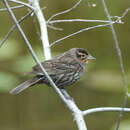en
names in breadcrumbs


A small (7-9 ½ inches) blackbird, the male Red-winged Blackbird is most easily identified by its small size, black body, and red-and-yellow “shoulder” patches visible as part of the male’s display. Female Red-winged Blackbirds are streaked brown overall with faint tan eye-stripes. Males are unmistakable when their bright patches are visible, and no other female blackbird in North America is so heavily streaked. The Red-winged Blackbird breeds primarily from Alaska and northwestern Canada south to northern Central America. In winter, northerly-breeding populations migrate south to the southern U.S. Populations breeding further south are generally non-migratory. Red-winged Blackbirds breed in wetland habitats, including freshwater and saltwater marshes, damp grasslands, and flooded fields where rice is grown. Birds that migrate utilize similar habitats in the winter as in summer. Red-winged Blackbirds primarily eat insects during the summer, switching to a diet composed of seeds and grains in the winter. In appropriate habitat, Red-winged Blackbirds are most easily seen while foraging for food on the stalks and leaves of marsh grasses. During the breeding season, males may be observed displaying their “shoulder” patches from prominent perches in the grass while singing this species’ buzzing “konk-la-ree” song. Red-winged Blackbirds are primarily active during the day.